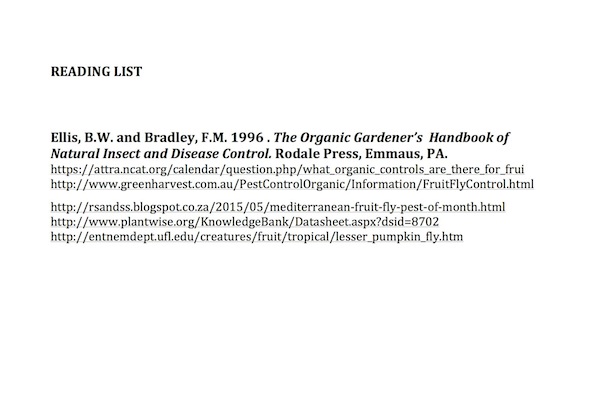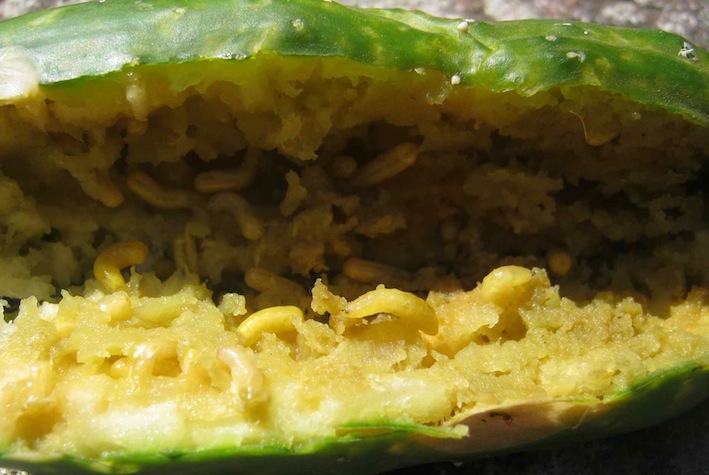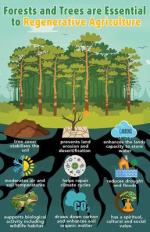The fruit fly life cycle and finding organic control measures
Understanding the fruit fly life cycle helps in creating means of controlling fruit flies, which can wreak havoc on the harvest of fruit bearing plants from peaches to pumpkins. In response to fruit flies farmers and researchers have come up with an arsenal of tricks to use for combatting them. Organic or non-toxic methods are basic to any prevention program, whether or not insect-poisons are used. One must
remember that these poisons are non specific, and will also kill insects vital to vegetable harvesting, such as bees. With the worldwide crash in bee numbers, and species, it would be wise to avoid using any methods which can impact them negatively. As these articles will be about treating fruit flies in general, here follows a very general outline of the usual life cycle of most fruit flies. The life cycle gives insight into how to fight against fruit fly laying eggs on your fruit and or increasing in numbers. The control methods will be found in separate articles based on the broad type of method you’re using.
the average fruit fly life cycle
Although identifying the species of fruit fly you may be dealing with can be crucial in the fight against crop loss, the identification is sometimes not so simple, therefore as a start I’m tackling general fruit fly control and the first vital knowledge is of the average fruit fly life cycle.
In late summer the fruit flies emerge from their pupae, a dormant stage between the larva or maggot and the adult stage. They mate and lay eggs. A female fruit fly can lay several hundred eggs in her lifetime. She punctures the preferably soft skin of a fruit and lays her eggs just beneath the surface. These can number from one to a group of 75, depending on the species, and other females may lay their eggs in the same hole. The eggs hatch from thirty six hours to twenty days later, depending on species and environmental temperature. The larvae or maggots, usually just under 1cm in length and creamy white, eat tunnels through the fruit for between ten and twenty six days. They destroy the fruit with their tunnels, and introduce bacteria, causing it to rot. At this stage the larvae drop out of the fruit onto the ground, or the fruit drops with the larvae in it. They then burrow down and pupate in the top ten centimetres of the soil. Adult flies may emerge within six to a hundred days, depending on species and temperature, with many
successive generations in one summer, or staying dormant over winter. Adult flies can also overwinter, and can fly 20km to find a host plant, and survive up to six months without food in cooler climates. In warmer climates they shelter in lush vegetation during the heat of the day and fly in the morning and afternoon. They may feed on honeydew, rotten fruit, plant sap or feces. Some serve as pollinators of other plants. Adult flies may be attracted to various odours or chemicals, and that is an area where identification can be crucial to finding the right lure. Identification is also vital for determining their preference for different plants for sheltering and feeding, as these plants can be used as lures.
a brief overview of control measures and their dependence on the fruit fly life cycle
The most foundational non-toxic method for combatting fruit fly is cleaning up, often called sanitizing, in which infected fruit are removed from the plant, and destroyed, cutting off the life cycle of the fruit fly. Furthermore one can select for resistant, or easily cleaned and managed dwarf fruit species or for the timing of your harvest to diminish the effects of fruit fly. One can exclude fruit fly from contact with your fruit and thus the possibility of eggs being laid, by covering them with bags or dusting them with a substance which repels the female insects.
One can reduce contact with vulnerable fruit varieties by increasing planting biodiversity in the garden. This also increases the presence of diverse organisms and thus encourages predation of the fruit fly naturally by parasites.
Parasites can also be introduced, as can predators such as chickens which scratch through the soil and eat the pupae. A step up in technologically is the release of sterile male flies to reduce the fly population.
Then of course there is the use of various commercial or home made baits to attract and kill the flies without any poisons touching your actual harvest. It is in such cases that danger to bees exists, as well as in the spraying of insecticides, whether they be certified as organic or not. See the page on organic fruit fly control with baits, traps and poisons.
------
------
Vegetable gardening the natural and low cost way
------
------
a useful link to more information on fruit flies in general

Restore Nature Newsletter
I've been writing for four years now and I would love to hear from you
Please let me know if you have any questions, comments or stories to share on gardening, permaculture, regenerative agriculture, food forests, natural gardening, do nothing gardening, observations about pests and diseases, foraging, dealing with and using weeds constructively, composting and going offgrid.
SEARCH
Order the Kindle E-book for the SPECIAL PRICE of only
Prices valid till 30.09.2023
Recent Articles
-
Rose
Dec 17, 23 04:08 AM
I am doing research on growing wildlife foraging plants to use in enhancement plantings with wildlife in mind. My thoughts after seeing bears too skinny -
Seeds for a bred Sweeter less acidic Kei apple
Nov 20, 23 03:24 AM
Greetings Greenidiom, I'm a small farmer in kenya. I'm looking to plant a Green fence around a 6 acre plot of land and, I'd wish to make it of kei apples -
Mrs Laura Robinson
Oct 08, 23 02:17 AM
How do I get a copy of the soil aggregation poster??
"How to start a profitable worm business on a shoestring budget
Order a printed copy from "Amazon" at the SPECIAL PRICE of only
or a digital version from the "Kindle" store at the SPECIAL PRICE of only
Prices valid till 30.09.2023







